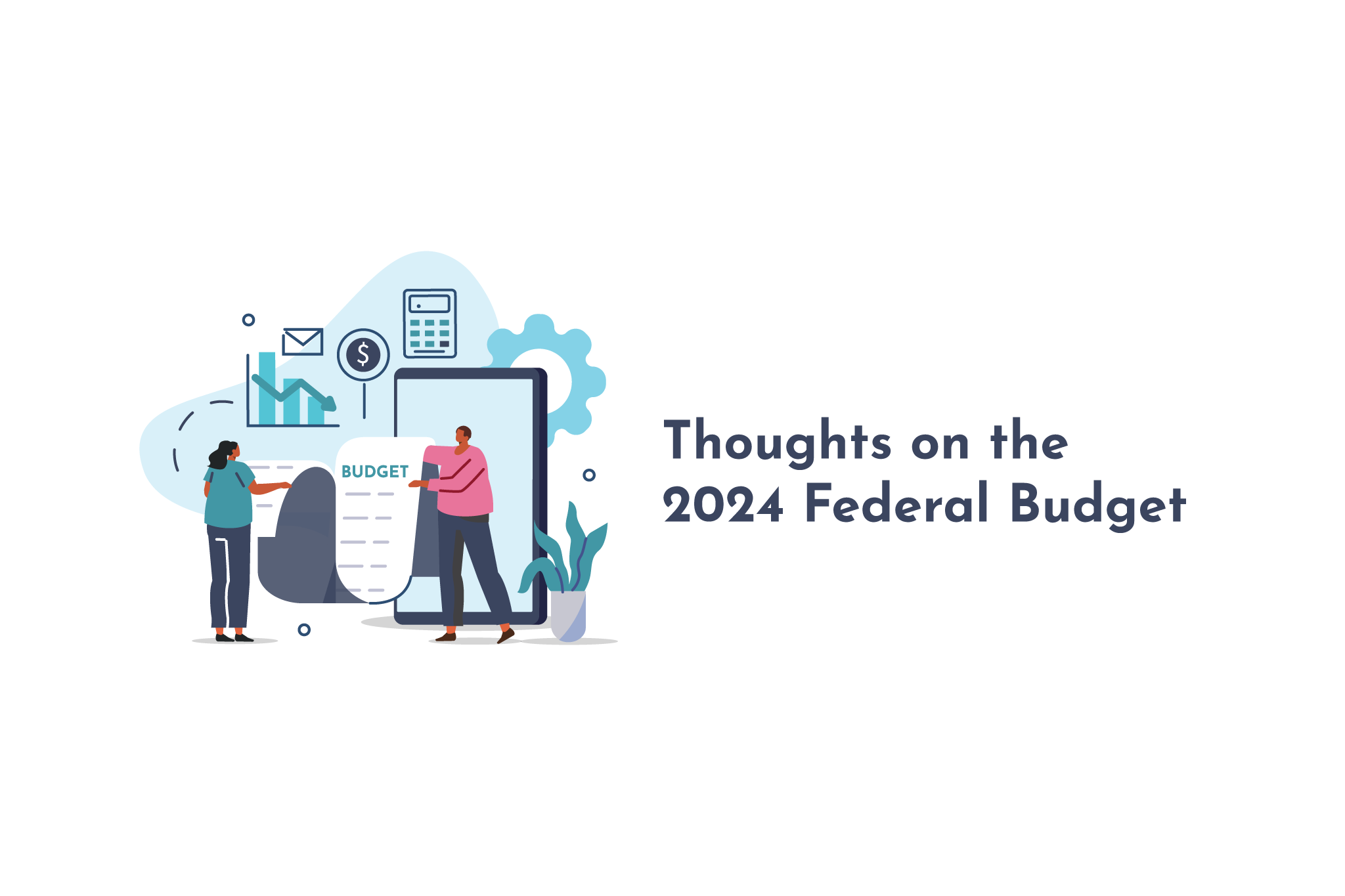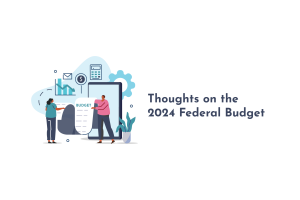Monetary policy has been at the forefront of so many things in the past year. As the country progressed out of the unprecedented conditions associated with the COVID-19-related lockdowns, we moved into a period of high inflation and the resulting fight against it that the Bank of Canada undertook by raising interest rates. This week, the Liberal government revealed its 2024 federal budget, which also appears to be targeting some of the issues that inflation created by including ways to try and make homeownership more achievable as part of the plan. Overall, there is a plan to increase spending in the upcoming year. Unfortunately, this means that there will also be increased taxation to help fund this new spending.
In This Article:
- The Elephant in the Room
- Changes to Capital Gains Inclusions
- Changes to the rules regarding Home Ownership
- One More ‘Fun’ thing for you to deal with as a consumer
- Conclusion
2024 Federal Budget: The Elephant in the Room
In 2023 and 2024, this is inflation. Inflation is by far the biggest fight that the government faces with monetary policy right now, and it was an area that they tried to address with some of the budget announcements. Let’s look at what is going on outside of this budget, though. Around the same time that the government released its new budget, the annual inflation rate data was also released for March. The inflation rate was 2.9%, a number that exceeds the Bank of Canada’s target rate of 2%. Now, let’s consider what drives inflation. I can’t be the only one who questions how fighting inflation can be so important while at the same time being hit with an increase of 3.3 cents per litre for gasoline due to taxes when I fill up my car. One of the key components of the inflation rate is the rising cost of fuel, so how can you responsibly say that you are fighting to lower inflation by increasing interest rates and making everyone’s life a bit more difficult while at the same time increasing taxes that drive up the key components of inflation? This makes no sense to me.
I’m going to get nerdy here for a minute. Have you ever considered the concept of biomagnification and drawn a parallel to how it works and how what you pay for things for your home mirrors this principle? Maybe not, so here’s how biomagnification works. This is the idea that when something low down in the food chain becomes contaminated, the concentration of contamination increases at subsequent levels of the food chain. Say that a lake gets contaminated with a pesticide that the plankton in the lake absorbs; it’s not enough to kill the plankton, but it is present in their system. The fish in that lake eat a large quantity of plankton as part of their diet, so they have more pesticide buildup in their tissue because of how much they eat. Then you look further up the food chain at something like a bear, which eats a lot of fish to survive. Here, the contaminant builds up even more because the fish that they are eating have more contaminants in them. Basically, at every step up the chain, the contamination increases and can potentially result in situations where the organisms at the top of the food chain die from ingesting too much of the contaminant that was originally only present in microorganisms.
Now, let’s think about taxation and how it looks like this. If the source of your food is hit with a tax that increases their cost, they have two choices. The first is to try and absorb the tax, make smaller profits and hope they can survive (no one actually chooses this). The second choice is to pass the extra cost along to the people who buy things from them. Imagine you are a farmer who is faced with rapidly increasing costs for basic things that are required to complete your job. Heating your barns and drying grain, for example, both rely on fossil fuels to complete the task. Canadian farmers estimate that to run a poultry farm in Alberta; they are facing an increase in the cost of $100,000 a year based solely on the costs of the federal carbon tax . When faced with a cost increase like this it is a necessity for the farmer to pass on some of the cost to the next person in the supply chain. They cannot simply be expected to eat a cost increase at that level. In reality, the production of poultry from start to finish involves multiple steps, with each step facing higher costs because the previous step had to charge them more to offset their increased tax burden, not to mention that they have been hit with the same higher taxes as well. Think back to the bioaccumulation principle. At each step in the process, expenses are higher because each of the previous steps had increased costs. By the time food reaches the grocery store, there have been multiple steps that all have increased costs due to farmers being faced with a tax burden that they could not avoid passing up the chain unless they wanted to bankrupt themselves. These costs are all passed on to the next link in the chain until they arrive at the end. Unfortunately, the end of the chain is your wallet and mine. It costs more to buy everything right now because we are being taxed into oblivion.

2024 Federal Budget: Changes to Capital Gains Inclusions
One of the key areas that the government addressed in the 2024 budget to generate higher revenue (AKA charge more taxes) is the inclusion of capital gains. Since the year 2000, the capital gains inclusion rate for the purposes of paying income taxes has been 50%. This rate was set to 50% in 2000 by the then-ruling Jean Chretien-led liberal party because it was believed that by only taxing 50% of a capital gain, it incentivized people and businesses to make investments in things that required some risk. The argument has been made that the 50% inclusion rate only really benefits the wealthy in Canada since they are typically the ones who realize the largest gains. The change proposed in the budget will increase the inclusion rate on gains over $250,000 from 50% to 66.67%. There were a few corresponding changes as well. The lifetime capital gains exemption will increase, offsetting some of the gains that could be triggered by the sale of a qualifying business. However, overall, what does this mean? The claim is that, in most cases, there will be little effect on taxpayers. The fact that you need to have more than $250,000 in capital gains in a single year to trigger the higher inclusion rate means that you may need to be more strategic in how you dispose of investments, but a strong financial plan can help with this. Business owners in sectors like tech see the increase as a detriment to drawing investment money because, if successful, they can create huge capital gains for investors. If you have to pay more tax on those gains, investors may be less inclined to support these types of businesses. One of the biggest issues that may arise comes from deemed dispositions upon the death of a taxpayer. Since all of your assets are deemed to have been disposed of when you die, your estate may face a significant increase in its tax burden because it faces the new inclusion rate. Again, make sure that you take the time to discuss how this changes your overall estate plan with your financial advisory team.
2024 Federal Budget: Changes to the rules regarding Home Ownership
One of the biggest challenges that people face today is entry into the homeownership market. Buying your first home has been increasingly difficult, with real estate values experiencing rapid growth and, at the same time, higher interest rates making qualifying for mortgages more difficult. A few of these changes are:
- Home Buyers Plan Change – The limit for withdrawals from your RRSP as part of the Home Buyers Program is being increased from $35,000 to $60,000. The payment grace period is also being extended from two years to five years before you have to start repaying the withdrawal.
- Mortgage Rule Changes – First time home buyers will be allowed to extend their mortgage repayment terms out to 30 years if they purchase a home worth less than $1 Million.
- Rental payments – You will start to be able to count payments you make towards renting a property to improve your credit score, again making mortgage qualification easier.
- Secondary Suite Loan Program – Homeowners will be able to access up to $40,000 in low-interest loans to help add secondary suites to their homes.
All of these changes are aimed at making it easier for people entering into home ownership for the first time. There is also mention of making Halal Mortgages available to Canadians. These are mortgages that would fall under the introduction of alternative financing products and aim to make it more feasible for Muslim Canadians to purchase homes and still be able to follow the Islamic law that prevents Muslims from charging or collecting interest. Halal mortgages make use of different payment structures, eliminating interest from the equation and thus allowing for homeownership for more Muslim families without needing to break a tenet of their faith. Overall, the budget supports Canadians’ dream of becoming homeowners. The downside to this is that as long as the demand for housing exceeds the supply (the CHMC estimates that we need 3.5 million new housing units to match supply and demand), what may effectively happen is that we are adding new buyers to a marketplace where the advantage is in the seller’s hands and drive prices up even further. Time will tell what the outcome is.

One More ‘Fun’ thing for you to deal with as a consumer
Get ready for the ‘Netflix Tax‘. This is the newly minted Digital Services Tax and it is going to be applied to the revenue generated in Canada by companies like Amazon, Google and Netflix. Predicted to be 15%, I am sure that these companies will absorb this increase and reduce their profits accordingly. There’s no way that they will simply pass along the cost to the consumer.
Conclusion
The 2024 federal budget contained lots of items outside of what we discussed here. The reality is that the budget always includes many items that may or may not directly impact the daily lives of many Canadians. The idea that the capital gains inclusion only changes after you’ve declared an annual gain of $250,000 sounds like an astronomical amount to most people and seems like a ‘champagne problem’ to so many of us. The consensus from many economists is that while it strives to address many social issues that the government has promised to provide, the reality is that it does little to actually fight against inflation. To help make sure you don’t have to choose between heating your home and buying food in the near future, you will need to look somewhere other than the 2024 federal budget.
If you’re seeking strategies to optimize your income, consider our cash flow planning services. Schedule a call with one of our financial advisors today.




